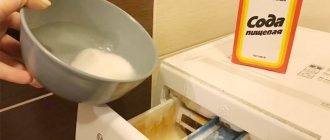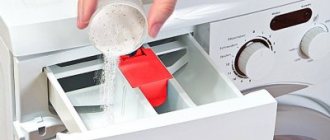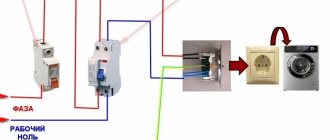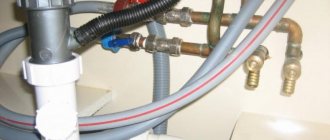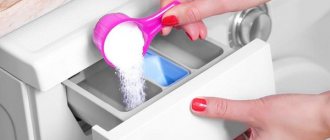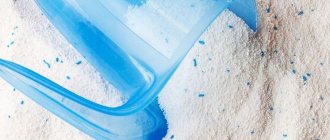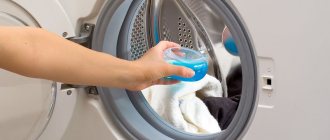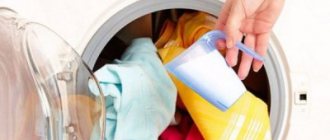Each manufacturer's instructions for using an automatic machine contains information about the rules for loading household chemicals to obtain an effective washing result.
If the documents do not contain a description in Russian, they are lost, or a unit was purchased that was used, tips from professionals and experienced housewives will help you understand the function of the cells in the tray.
We'll tell you in the article where to put the powder (as well as pour the gel, place capsules, tablets, etc.) into the washing machine.
What is the correct way - in which compartment, cell?
All products are loaded into the tray (cuvette) of the washing machine before the program starts . If the housewife forgot to add some product, it can be added later if the washing stage with its use has not yet begun.
The tray is made of plastic. Its front panel has the color of the body, the inside is white or gray.
The retractable cuvette has from 2 to 4 cells. Each performs its own function and is marked for convenience. There is no single system for designations; different manufacturers use Roman, Arabic numerals or Latin letters.
Description of the cells of a typical drawer cuvette:
| Marking | Size | Accessories | Function | What to download |
| 1, I, A | average | none | pre-soak, double wash cycle | powder, starching agent (loose only) |
| 2, II, B | big | curtain | main loop | bulk, liquid detergents, bleaches, stain removers, softeners |
| Softener, *, flower | small | overflow valve | laundry care | conditioner, fabric softener (liquids only) |
The cap marked MAX (overflow valve) is not a dispenser ; it shows the maximum amount of product that can be poured into the conditioner compartment.
A curtain (special partition) in the cell for the main cycle is necessary for the transition from liquid detergent (it is lowered before pouring) to bulk detergent (raised) and vice versa.
The number, structure and location of cells for household chemicals may vary from manufacturer to manufacturer.
What happens if you load it into the wrong compartment?
According to manufacturers and service workers, using the tray compartments for purposes other than their intended purpose will not harm the washing machine . If the housewife mixes up the cells and the powder gets into, for example, the conditioner cell, only the quality of the wash will suffer.
Not only will the laundry not get rid of dirt during the process, but it will also receive a soapy solution when rinsing. This will lead to additional consumption of household chemicals, electricity and water. The unit will have to be loaded again and the wash cycle repeated.
What happens if you put it in the wrong place?
It is not without reason that the powder receptacle is divided into compartments. The whole point is that the machine gradually selects the required amount of detergent in accordance with the specified program. Gradual mixing of powder with water ensures the highest quality and safe washing.
Should we expect serious problems if the powder is poured in the wrong place? No. The only thing that can happen in a situation where the powder is poured into the wrong cell is that the quality of the wash will suffer .
Differences for machines with different loading
A significant difference between top-loading and horizontal-loading washing machines is the location of the tray with cells for detergents, bleaches and softeners.
For units with vertical loading, the container is located directly in the hatch . The downside of such models: you won’t be able to add the product after the program has started; you can stop it temporarily. In modern models, manufacturers have added a reloading function.
For washing machines with side (horizontal) loading, the container for household chemicals is located in the upper left corner of the front wall. You can open the retractable cuvette at any stage of the wash cycle.
Is it possible to pour directly into the drum?
To answer this question, you need to refer to the washing machine manufacturer's instructions.
In most cases, this is not recommended , with the exception of some types of household chemicals for washing children's clothes.
It is strictly forbidden to put stain removers and bleaches into the drum; they are used only in specially designated compartments of the tray.
The granular structure and more aggressive composition of bulk products are not the best option for proximity to fabrics; mechanical damage and partial loss of the original color are guaranteed.
It is better to pour the powders into a special compartment from which it will be washed , dissolved along the way of transportation and evenly distributed in the drum.
If the housewife is sure that the bulk product in the drum will bring more benefits, then it is necessary to place it in a special container (a device in the form of a ball with holes), often included with the washing machine.
Possible difficulties
If the washing powder remains untouched in the tray after washing, and your clothes are quite dirty, this means that problems have arisen during the washing process.
What could be the reasons for such problems?
- We chose the wrong mode for washing. It often happens that a person simply forgets or confuses the modes.
- There were problems with the water supply. You need to check the required valve and the pressure of the supplied water.
- A large amount of powder. More powder has been poured than required by the regime.
- Problems with the dispenser. Difficulties may arise when feeding detergent into the middle of the centrifuge due to the fact that it is simply clogged. You need to remove the container from the washing machine and check its condition.
If you were unable to resolve the problem on your own, then you should definitely turn to specialists for help.
Dosage
Information on the recommended amount of detergent can be found in the instructions of the manufacturers of household chemicals for washing machines. If it is not possible to study them, there is a proven standard: 1 tbsp. l of powder (25 g) per 1 kg of loaded laundry.
The quantity can be doubled if:
- the degree of soiling of the laundry is high, there are old stains;
- the water quality is inadequate, it is hard;
- A washing program for certain types of laundry requires more water.
In other cases, it is not recommended to exceed the standard, otherwise the unit may fail due to high foaming.
Dosing correctly
The dosage of detergents depends on a number of factors:
Surfactant concentration in washing powder. The higher it is, the less detergent required.- The amount of laundry and the degree of soiling. To wash 1 kg of clothes, on average, take 1 tablespoon of powder.
- Water hardness level. The higher it is, the worse the detergent composition works.
- Washing program and its duration.
The powder is packaged in packaging that contains detailed information on its use and dosage. It’s good if the manufacturer took care to supplement their detergent with a measuring spoon or cup.
If you apply too much product, excess foam will form . At best, the machine will simply stop washing. At worst, a leak will occur and repairs will be required.
Where should gels, capsules, plates be placed?
Liquid laundry detergents (gels, concentrates) can be used in several ways:
- In the cell labeled II, 2, B.
- In the drum of a washing machine.
- Place in a special dispenser and send to a load of laundry.
Before loading the product into the drum, you must study the manufacturer's recommendations. In some models this is strictly prohibited.
Direct loading of industrial liquid is undesirable if:
- it contains bleaching particles, direct contact leads to the formation of stains on fabrics;
- the composition contains components that prevent the formation of scale, in this case they do not have an effect;
- The main wash compartment is already loaded with dry powder.
Capsules, tablets, plates are more convenient to use; one piece is enough for washing with a load of up to 5 kg. They are placed directly into the drum before starting the unit, the laundry is placed on top. They dissolve quickly and are distributed evenly.
Washing tablets can also be placed in the main wash compartment . But housewives note that they deal with dirt most effectively when loading them into the drum.
Differences in the design of trays between different manufacturers
In most cases, the number and location of cells for detergents and care products is standard: 3 containers in a pull-out cuvette.
But there are exceptions:
- LG sometimes only offers 2 compartments (in older models). Soaking products (small compartment on the right) and care products (insert) are loaded into one compartment.
- The main difference between Indesit is the cuvette for bleaching substances, which has a compartment for liquids and bulk or concentrated (thick) products.
- Some Samsung models have an additional compartment in the prewash compartment. It is designed to load bleach. If the cell is not removed, the pre-soak program cannot be started.
- Most Bosh machines have a starch compartment added. Starch can only be loaded into the cell in the form of a solution with water.
If the location is atypical, markings will help you understand the compartments of the tray for loading household chemicals.
Cuvette care
The tray for household chemicals in a washing machine is an important part and requires additional care, despite constant contact with detergents.
In order for the unit to operate normally, it must be washed and dried to prevent the occurrence of:
- raid,
- mold,
- clogging of filters and pipes.
In modern front-loading machines, the tray can be easily removed using a special button (PUSH) or a plastic lever located in the rinsing compartment. If the listed devices are missing, you should pull the retractable cuvette and it will come out.
Recommendations for processing:
- It is necessary to clean after every 3 washes;
- be sure to use a brush or sponge, special household chemicals;
- You can use folk remedies: citric acid, soda, vinegar, its essence.
You will find a lot of useful and important information about washing powder here.
Errors and how to resolve them
The most common error codes and ways to eliminate them:
- 1, E1, E01 – problems with blocking the hatch. You need to try to close the door more tightly, if this does not help, the UBL needs to be repaired.
- 2, E2, E02 – problems with water intake: there is not enough of it, or too much. It is necessary to check the supply valve, pressure switch and contacts leading to these parts.
- 3, E3, E03 – water does not drain. You need to check the drain hose, filter and pump; perhaps a blockage has formed in one of the areas.
- 4, E4, E04 – there is too much water in the tank. The pressure switch, water supply valve or control module is faulty.
- 5, E5, E05 – problems with water heating. The temperature sensor or heating element may be damaged.
- 6, E6, E06 – malfunctions in the operation of the control board. Most often, the reason lies in its failure; the machine needs to be rebooted or a part needs to be replaced.
- 7, E7, E07 – the motor has failed. It is being repaired or replaced.
- 8, E8, E08 – tachogenerator failure, part replacement required.
- 9, E9, E09 – the motor does not receive power. Most often the starter fails.
- 10, E10 – program selector failure. You can try to clean it, or restart the machine. If this does not help, the part is changed.
- 11, E11 – failure of the drying heating element.
- 12, E12 – failure of the heating element temperature sensor. It cannot be repaired, it needs to be replaced.
- 13, E13 – failure of the control module. If you cannot solve the problem by rebooting, the board needs to be reflashed or replaced.
- 14, E14 – failure in the heating circuit. The problem may be hidden in the wiring, heating element or temperature sensor.
- 15, E15 – malfunctions in the operation of the control board.
- 16, E16 – short circuit of the heating element or failure in the control board. The device needs to be rebooted.
- 17, E17 – problems with the tachogenerator or motor.
- 18, E18 – low voltage or surges. You need to turn off the device and continue washing after the situation has stabilized.
- 20, E20 – failure of the pressure switch. The part must be replaced and cannot be repaired.
- 21, E21 – the water level in the tank is determined incorrectly. The reason lies in the breakdown of the pressure switch or the wires leading to it.
- 22, E22 – error in the heating circuit. There may be a malfunction in the control board.

